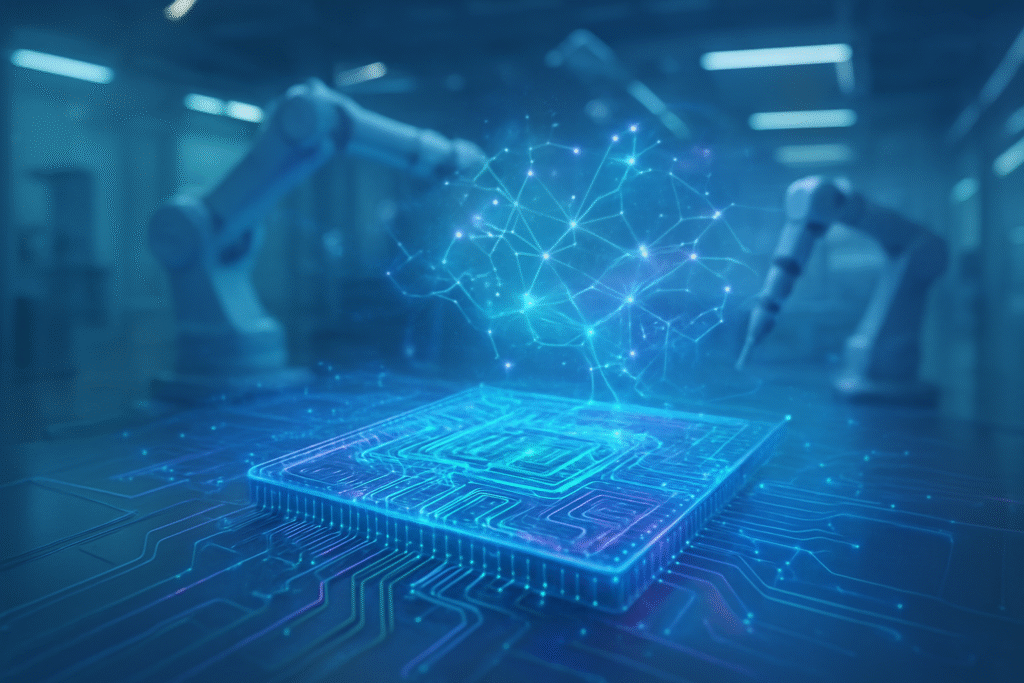
The semiconductor industry, the bedrock of modern technology, is experiencing a profound transformation, spearheaded by the pervasive integration of Artificial Intelligence (AI). This paradigm shift is not merely an incremental improvement but a fundamental re-engineering of how microchips are conceived, designed, and manufactured. With the escalating complexity of chip architectures and an insatiable global demand for ever more powerful and specialized semiconductors, AI has emerged as an indispensable catalyst, promising to accelerate innovation, drastically enhance efficiency, and unlock unprecedented capabilities in the digital realm.
The immediate significance of AI's burgeoning role is multifold. It is dramatically shortening design cycles, allowing for the rapid iteration and optimization of complex chip layouts that previously consumed months or even years. Concurrently, AI is supercharging manufacturing processes, leading to higher yields, predictive maintenance, and unparalleled precision in defect detection. This symbiotic relationship, where AI not only drives the demand for more advanced chips but also actively participates in their creation, is ushering in what many industry experts are calling an "AI Supercycle." The implications are vast, promising to deliver the next generation of computing power required to fuel the continued explosion of generative AI, large language models, and countless other AI-driven applications.
Technical Deep Dive: The AI-Powered Semiconductor Revolution
The technical advancements underpinning AI's impact on chip design and manufacturing are both sophisticated and transformative. At the core of this revolution are advanced AI algorithms, particularly machine learning (ML) and generative AI, integrated into Electronic Design Automation (EDA) tools and factory operational systems.
In chip design, generative AI is a game-changer. Companies like Synopsys (NASDAQ: SNPS) with its DSO.ai and Cadence (NASDAQ: CDNS) with Cerebrus AI Studio are leading the charge. These platforms leverage AI to automate highly complex and iterative design tasks, such as floor planning, power optimization, and routing. Unlike traditional, rule-based EDA tools that require extensive human intervention and adhere to predefined parameters, AI-driven tools can explore billions of possible transistor arrangements and routing topologies at speeds unattainable by human engineers. This allows for the rapid identification of optimal designs that balance performance, power consumption, and area (PPA) – the holy trinity of chip design. Furthermore, AI can generate unconventional yet highly efficient designs that often surpass human-engineered solutions, sometimes even creating architectures that human engineers might not intuitively conceive. This capability significantly reduces the time from concept to silicon, a critical factor in a rapidly evolving market. Verification and testing, traditionally consuming up to 70% of chip design time, are also being streamlined by multi-agent AI frameworks, which can reduce human effort by 50% to 80% with higher accuracy by detecting design flaws and enhancing design for testability (DFT). Recent research, such as that from Princeton Engineering and the Indian Institute of Technology, has demonstrated AI slashing wireless chip design times from weeks to mere hours, yielding superior, counter-intuitive designs. Even nations like China are investing heavily, with platforms like QiMeng aiming for autonomous processor generation to reduce reliance on foreign software.
On the manufacturing front, AI is equally impactful. AI-powered solutions, often leveraging digital twins – virtual replicas of physical systems – analyze billions of data points from real-time factory operations. This enables precise process control and yield optimization. For instance, AI can identify subtle process variations in high-volume fabrication plants and recommend real-time adjustments to parameters like temperature, pressure, and chemical composition, thereby significantly enhancing yield rates. Predictive maintenance (PdM) is another critical application, where AI models analyze sensor data from manufacturing equipment to predict potential failures before they occur. This shifts maintenance from a reactive or scheduled approach to a proactive one, drastically reducing costly downtime by 10-20% and cutting maintenance planning time by up to 50%. Moreover, AI-driven automated optical inspection (AOI) systems, utilizing deep learning and computer vision, can detect microscopic defects on wafers and chips with unparalleled speed and accuracy, even identifying novel or unknown defects that might escape human inspection. These capabilities ensure only the highest quality products proceed to market, while also reducing waste and energy consumption, leading to substantial cost efficiencies.
Initial reactions from the AI research community and industry experts have been overwhelmingly positive, albeit with a keen awareness of the ongoing challenges. Researchers are excited by the potential for AI to unlock entirely new design spaces and material properties that were previously intractable. Industry leaders recognize AI as essential for maintaining competitive advantage and addressing the increasing complexity and cost of advanced semiconductor development. While the promise of fully autonomous chip design is still some years away, the current advancements represent a significant leap forward, moving beyond mere automation to intelligent optimization and generation.
Corporate Chessboard: Beneficiaries and Competitive Dynamics
The integration of AI into chip design and manufacturing is reshaping the competitive landscape of the semiconductor industry, creating clear beneficiaries and posing strategic challenges for all players, from established tech giants to agile startups.
Companies at the forefront of Electronic Design Automation (EDA), such as Synopsys (NASDAQ: SNPS) and Cadence Design Systems (NASDAQ: CDNS), stand to benefit immensely. Their deep investments in AI-driven EDA tools like DSO.ai and Cerebrus AI Studio are cementing their positions as indispensable partners for chip designers. By offering solutions that drastically cut design time and improve chip performance, these companies are becoming critical enablers of the AI era, effectively selling the shovels in the AI gold rush. Their market positioning is strengthened as chipmakers increasingly rely on these intelligent platforms to manage the escalating complexity of advanced node designs.
Major semiconductor manufacturers and integrated device manufacturers (IDMs) like Intel (NASDAQ: INTC), Samsung (KRX: 005930), and TSMC (NYSE: TSM) are also significant beneficiaries. By adopting AI in their design workflows and integrating it into their fabrication plants, these giants can achieve higher yields, reduce manufacturing costs, and accelerate their time-to-market for next-generation chips. This translates into stronger competitive advantages, particularly in the race to produce the most powerful and efficient AI accelerators and general-purpose CPUs/GPUs. The ability to optimize production through AI-powered predictive maintenance and real-time process control directly impacts their bottom line and their capacity to meet surging demand for AI-specific hardware. Furthermore, companies like NVIDIA (NASDAQ: NVDA), which are both a major designer of AI chips and a proponent of AI-driven design, are in a unique position to leverage these advancements internally and through their ecosystem.
For AI labs and tech giants like Google (NASDAQ: GOOGL), Amazon (NASDAQ: AMZN), and Microsoft (NASDAQ: MSFT), who are heavily investing in custom AI silicon for their cloud infrastructure and AI services, these developments are crucial. AI-optimized chip design allows them to create more efficient and powerful custom accelerators (e.g., Google's TPUs) tailored precisely to their workload needs, reducing their reliance on off-the-shelf solutions and providing a significant competitive edge in the cloud AI services market. This could potentially disrupt the traditional chip vendor-customer relationship, as more tech giants develop in-house chip design capabilities, albeit still relying on advanced foundries for manufacturing.
Startups focused on specialized AI algorithms for specific design or manufacturing tasks, or those developing novel AI-driven EDA tools, also have a fertile ground for innovation. These smaller players can carve out niche markets by offering highly specialized solutions that address particular pain points in the semiconductor value chain. However, they face the challenge of scaling and competing with the established giants. The potential disruption to existing products or services lies in the obsolescence of less intelligent, manual, or rule-based design and manufacturing approaches. Companies that fail to integrate AI into their operations risk falling behind in efficiency, innovation, and cost-effectiveness. The strategic advantage ultimately lies with those who can most effectively harness AI to innovate faster, produce more efficiently, and deliver higher-performing chips.
Wider Significance: AI's Broad Strokes on the Semiconductor Canvas
The pervasive integration of AI into chip design and manufacturing transcends mere technical improvements; it represents a fundamental shift that reverberates across the broader AI landscape, impacting technological progress, economic structures, and even geopolitical dynamics.
This development fits squarely into the overarching trend of AI becoming an indispensable tool for scientific discovery and engineering. Just as AI is revolutionizing drug discovery, materials science, and climate modeling, it is now proving its mettle in the intricate world of semiconductor engineering. It underscores the accelerating feedback loop in the AI ecosystem: advanced AI requires more powerful chips, and AI itself is becoming essential to design and produce those very chips. This virtuous cycle is driving an unprecedented pace of innovation, pushing the boundaries of what's possible in computing. The ability of AI to automate complex, iterative, and data-intensive tasks is not just about speed; it's about enabling human engineers to focus on higher-level conceptual challenges and explore design spaces that were previously too vast or complex to consider.
The impacts are far-reaching. Economically, the integration of AI could lead to an increase in earnings before interest of $85-$95 billion annually for the semiconductor industry by 2025, with the global semiconductor market projected to reach $697.1 billion in the same year. This significant growth is driven by both the efficiency gains and the surging demand for AI-specific hardware. Societally, more efficient and powerful chips will accelerate advancements in every sector reliant on computing, from healthcare and autonomous vehicles to sustainable energy and scientific research. The development of neuromorphic computing chips, which mimic the human brain's architecture, driven by AI design, holds the promise of entirely new computing paradigms with unprecedented energy efficiency for AI workloads.
However, potential concerns also accompany this rapid advancement. The increasing reliance on AI for critical design and manufacturing decisions raises questions about explainability and bias in AI algorithms. If an AI generates an optimal but unconventional chip design, understanding why it works and ensuring its reliability becomes paramount. There's also the risk of a widening technological gap between companies and nations that can heavily invest in AI-driven semiconductor technologies and those that cannot, potentially exacerbating existing digital divides. Furthermore, cybersecurity implications are significant; an AI-designed chip or an AI-managed fabrication plant could present new attack vectors if not secured rigorously.
Comparing this to previous AI milestones, such as AlphaGo's victory over human champions or the rise of large language models, AI in chip design and manufacturing represents a shift from AI excelling in specific cognitive tasks to AI becoming a foundational tool for industrial innovation. It’s not just about AI doing things, but AI creating the very infrastructure upon which future AI (and all computing) will run. This self-improving aspect makes it a uniquely powerful and transformative development, akin to the invention of automated tooling in earlier industrial revolutions, but with an added layer of intelligence.
Future Developments: The Horizon of AI-Driven Silicon
The trajectory of AI's involvement in the semiconductor industry points towards an even more integrated and autonomous future, promising breakthroughs that will redefine computing capabilities.
In the near term, we can expect continued refinement and expansion of AI's role in existing EDA tools and manufacturing processes. This includes more sophisticated generative AI models capable of handling even greater design complexity, leading to further reductions in design cycles and enhanced PPA optimization. The proliferation of digital twins, combined with advanced AI analytics, will create increasingly self-optimizing fabrication plants, where real-time adjustments are made autonomously to maximize yield and minimize waste. We will also see AI playing a larger role in the entire supply chain, from predicting demand fluctuations and optimizing inventory to identifying alternate suppliers and reconfiguring logistics in response to disruptions, thereby building greater resilience.
Looking further ahead, the long-term developments are even more ambitious. Experts predict the emergence of truly autonomous chip design, where AI systems can conceptualize, design, verify, and even optimize chips with minimal human intervention. This could lead to the rapid development of highly specialized chips for niche applications, accelerating innovation across various industries. AI is also expected to accelerate material discovery, predicting how novel materials will behave at the atomic level, paving the way for revolutionary semiconductors using advanced substances like graphene or molybdenum disulfide, leading to even faster, smaller, and more energy-efficient chips. The development of neuromorphic and quantum computing architectures will heavily rely on AI for their complex design and optimization.
However, several challenges need to be addressed. The computational demands of training and running advanced AI models for chip design are immense, requiring significant investment in computing infrastructure. The issue of AI explainability and trustworthiness in critical design decisions will need robust solutions to ensure reliability and safety. Furthermore, the industry faces a persistent talent shortage, and while AI tools can augment human capabilities, there is a crucial need to upskill the workforce to effectively collaborate with and manage these advanced AI systems. Ethical considerations, data privacy, and intellectual property rights related to AI-generated designs will also require careful navigation.
Experts predict that the next decade will see a blurring of lines between chip designers and AI developers, with a new breed of "AI-native" engineers emerging. The focus will shift from simply automating existing tasks to using AI to discover entirely new ways of designing and manufacturing, potentially leading to a "lights-out" factory environment for certain aspects of chip production. The convergence of AI, advanced materials, and novel computing architectures is poised to unlock unprecedented computational power, fueling the next wave of technological innovation.
Comprehensive Wrap-up: The Intelligent Core of Tomorrow's Tech
The integration of Artificial Intelligence into chip design and manufacturing marks a pivotal moment in the history of technology, signaling a profound and irreversible shift in how the foundational components of our digital world are created. The key takeaways from this revolution are clear: AI is drastically accelerating design cycles, enhancing manufacturing precision and efficiency, and unlocking new frontiers in chip performance and specialization. It’s creating a virtuous cycle where AI powers chip development, and more advanced chips, in turn, power more sophisticated AI.
This development's significance in AI history cannot be overstated. It represents AI moving beyond applications and into the very infrastructure of computing. It's not just about AI performing tasks but about AI enabling the creation of the hardware that will drive all future AI advancements. This deep integration makes the semiconductor industry a critical battleground for technological leadership and innovation. The immediate impact is already visible in faster product development, higher quality chips, and more resilient supply chains, translating into substantial economic gains for the industry.
Looking at the long-term impact, AI-driven chip design and manufacturing will be instrumental in addressing the ever-increasing demands for computational power driven by emerging technologies like the metaverse, advanced autonomous systems, and pervasive smart environments. It promises to democratize access to advanced chip design by abstracting away some of the extreme complexities, potentially fostering innovation from a broader range of players. However, it also necessitates a continuous focus on responsible AI development, ensuring explainability, fairness, and security in these critical systems.
In the coming weeks and months, watch for further announcements from leading EDA companies and semiconductor manufacturers regarding new AI-powered tools and successful implementations in their design and fabrication processes. Pay close attention to the performance benchmarks of newly released chips, particularly those designed with significant AI assistance, as these will be tangible indicators of this revolution's progress. The evolution of AI in silicon is not just a trend; it is the intelligent core shaping tomorrow's technological landscape.
This content is intended for informational purposes only and represents analysis of current AI developments.
TokenRing AI delivers enterprise-grade solutions for multi-agent AI workflow orchestration, AI-powered development tools, and seamless remote collaboration platforms.
For more information, visit https://www.tokenring.ai/.





